Thoughts on an important focus exhibition
There are still a couple of weeks in which to see “Women Artists of the Dutch Golden Age” at the National Museum of Women in the Arts (NMWA). If you live in the DC area, or if you visit the area over the holidays, make a point of seeing this gem of a show before it closes on January 5.

This exhibit highlights an important truth: not only did women in the seventeenth- and early eighteenth-century Netherlands practice art, but some of them were highly successful professional artists. As the exhibition brochure states, “Considered individually, the stories of the women represented in this exhibition demonstrate that there was not just one path to becoming an artist, nor was there only one model for success.” The display also clarifies the connections among the women, some of whom knew each other, and even worked together.
As a focus exhibition, the show is compact. It comprises some 20 works, and is contained within a single room. (I particularly appreciate that the walls are painted in the same shade of electric pink as Art Herstory’s accent color.) Most of the objects on display—from still life and genre paintings to botanical illustration to engravings—are from NMWA’s own collection, though a couple of paintings, and a book, are there on loan.
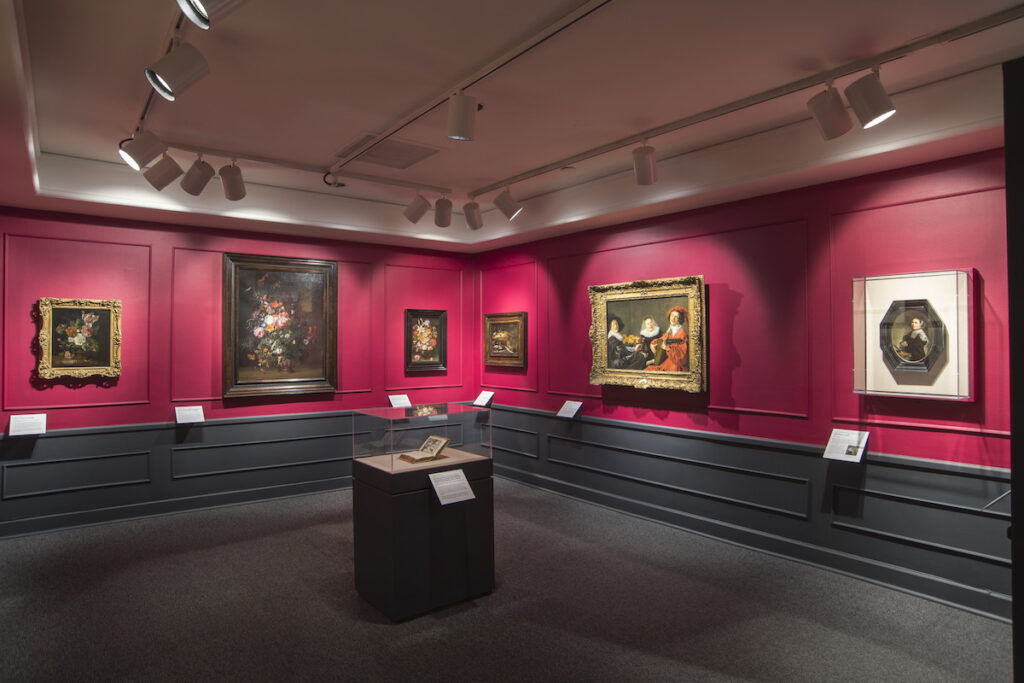
Paintings
Judith Leyster
Judith Leyster, one of the first women to be admitted to the Saint Luke’s Guild of Haarlem, is best known for her portraits and genre scenes, though she also painted some still lifes. Until recently, it was assumed there was only one Judith Leyster self-portrait still extant—her young self-portrait from 1633, held at the National Gallery of Art in Washington, DC. But in 2016, the auction house Christie’s discovered a previously unknown self-portrait of Leyster. In this “new” self-portrait from c. 1653, she is considerably older and more sedately dressed, but she still portrays herself with the tools of her trade: paint brushes and a palette.
Now in a private collection, this painting is one of the few loaned objects in the exhibition. It is something of a coup for NMWA to be able include this work in the show. For me, it was a particular thrill to see it “in person.” I am grateful to the owner for sharing it with a wider public.
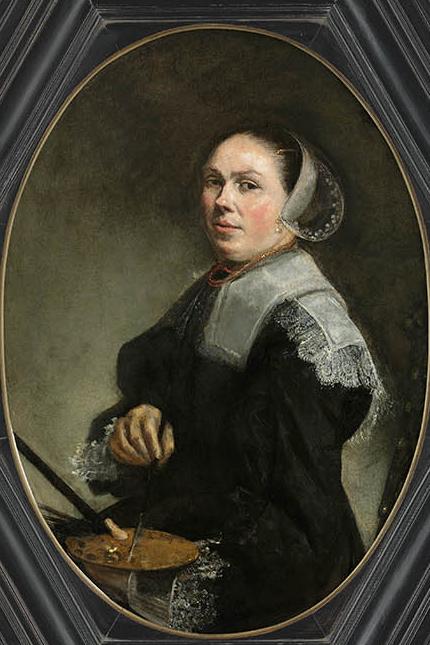
The other Leyster work on display, The Concert, is held in NMWA’s permanent collection. The information card accompanying the picture speculates that the woman at the center of the picture might be the artist herself, in yet another self-portrait. The figure on the right might be a portrait of Leyster’s future husband, artist Jan Miense Molenaer.
Rachel Ruysch
The daughter of an eminent Dutch professor of anatomy and botany, Rachel Ruysch became one of the most successful flower painters of the Dutch Golden Age. Since she was trained in scientific observation as well as in painting, collectors prized her works for their high degree of verisimilitude. Her still lifes seethe with life in the form of insects and butterflies.
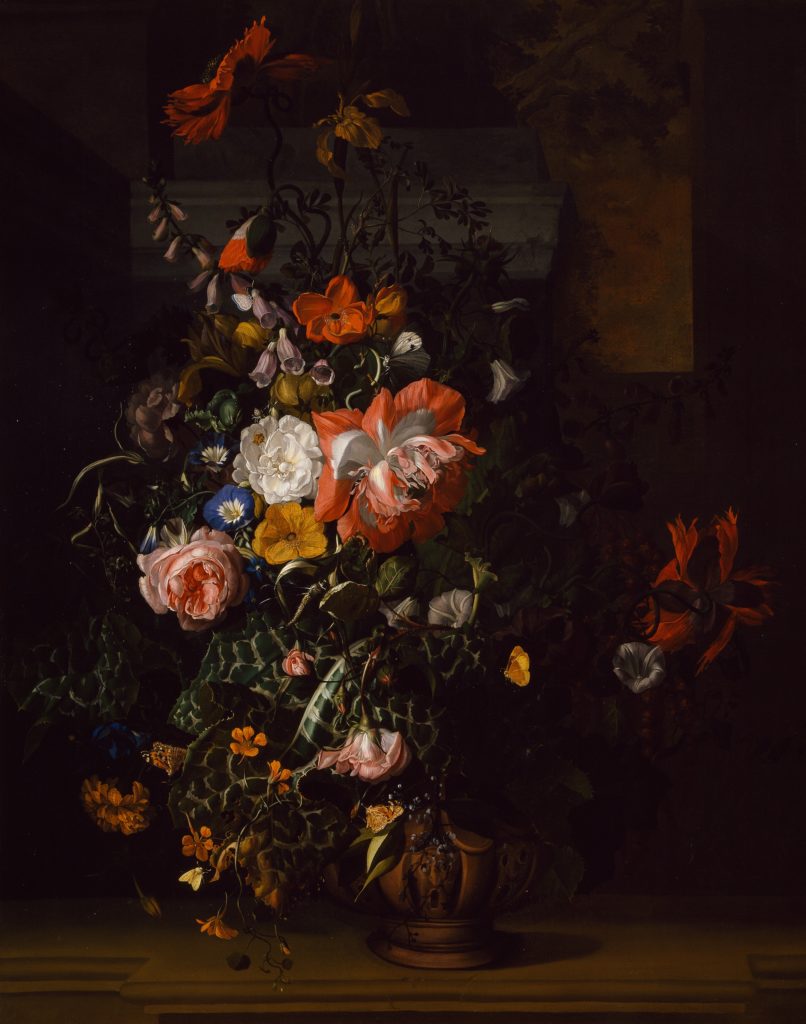
Like Leyster, Ruysch married an artist, Juriaen Pool. Apparently unlike Leyster, however, even as a wife and mother (of 11 children), she continued to work as a professional artist, producing hundreds of paintings. Many of them are still held in museum and private collections today. Her works are among the larger-scale paintings in the exhibition. The Ruysch work pictured above anchors the back wall; view the second Ruysch painting in the exhibit here.
Alida Withoos
Artist Mathias Withoos trained his children, including his daughter Alida, to produce still lifes and botanical illustrations. The two Alida Withoos paintings in this show are bosstilleven—forest still lives—a genre in which her father specialized. See also A Still Life with Roses, Daisies, an Iris, and other Flowers on a Forest Floor, ca. 1700.
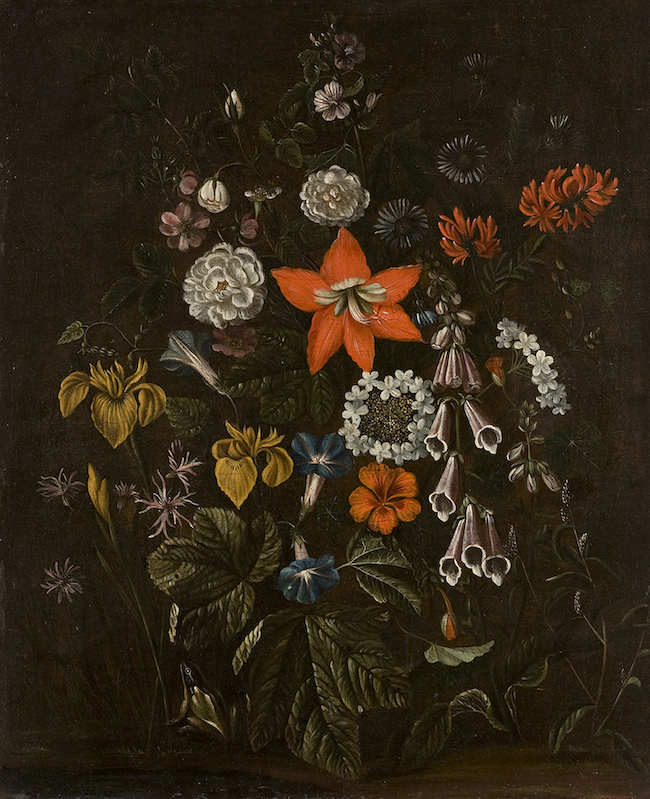
The exhibition brochure mentions that art patron and botanist Agnes Block (1629–1704) commissioned Alida Withoos to paint some of Block’s plants. The brochure also tells us that in 1694, the Hortus Botanicus (a botanical garden still in existence today in Amsterdam) hired Withoos to make drawings of thirteen of its plants. Some of Withoos’ botanical drawings—which may or may not relate to either of the commissions mentioned above—are held in New York, at the Met and the Morgan Library.
Clara Peeters
The only Flemish woman known to have specialized in still-life painting as early as the first decade of the seventeenth century, Clara Peeters is a pioneer among women artists. A few years ago, she was the subject of the Prado’s first exhibition to focus exclusively on a female artist (The Art of Clara Peeters, Winter 2016/17). The present show at NMWA includes two still lifes by Peeters: the glorious floral painting below (“a sugar banquet,” as it is described in a 1635 inventory), and Still Life of Fish and Cat.
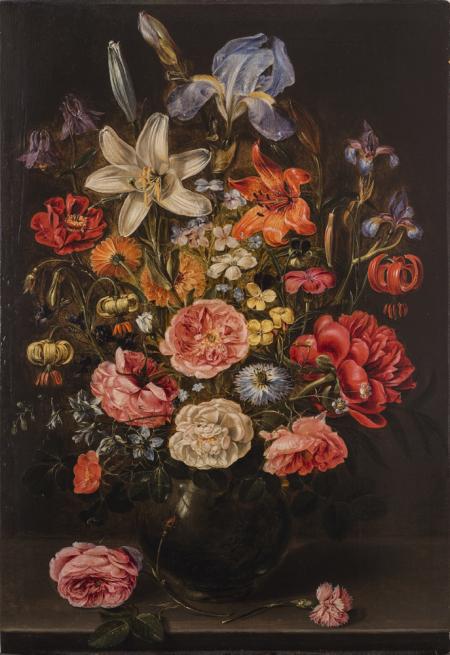
Maria Schalcken
It is clear from mentions of her works in eighteenth-century inventories that in her day, Maria Schalcken was a successful and sought-after artist. However, today only three surviving paintings are attributed to her. (One of these, a lovely self-portrait in the Rose-Marie and Eijk van Otterloo Collection, destined for the Museum of Fine Arts-Boston, features on an Art Herstory note card. The original is on view until January 12 in a special exhibition at the St. Louis Art Museum.) According to the NMWA information card, many of Schalcken’s works were misattributed—sometimes purposefully—as having been painted by her brother, Godfried Schalcken. It is possible that some now misattributed works may someday be reattributed to this artist. The Schalcken work included in the NMWA exhibition, Boy Offering Grapes to a Woman, is on loan from The Leiden Collection.

Botanical Illustrations/ Engravings
Maria Sibylla Merian
Maria Sibylla Merian was one of the first European naturalists to represent insects from direct observation, rather than from preserved specimens. Her illustrations are notable for considering the life cycles of insects, including representations of the plants that constitute each insect’s food source and/or habitat. In 1699, unusually for a woman—especially for one unaccompanied by a male companion—she undertook a journey to Surinam, then a Dutch colony, to study insects in their natural habitat. The present exhibition includes a set of hand-colored engravings on paper from her posthumously published book Dissertation in Insect Generations and Metamorphoses in Surinam (second edition).
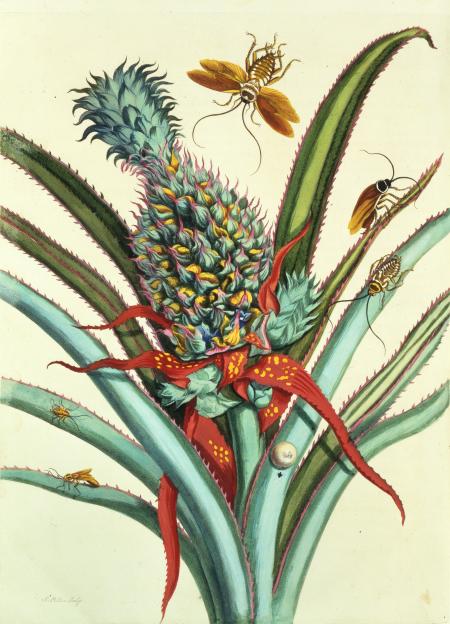
In Merian’s books, she writes about the uses and properties of plants. Much of this information she gleaned from local women in Suriname, including African women and women of the Carib and Arawak tribes, some of whom were enslaved to Europeans, including Merian.
Anna Maria van Schurman
A polymath, Anna Maria van Schurman was the first woman to attend university in the Netherlands. She was acclaimed as a poet and a scholar. She was also, according to her NMWA artist profile, “a prolific artist in a variety of mediums, including painting, engraving, calligraphy, and paper cutting.”

Van Schurman is the only non-professional among the women artists represented in this show, which includes (on loan) one of van Schurman’s book publications. She is connected in various ways with other artists represented in the exhibition:
- In one of the few known early examples of the training of one woman artist by another, Magdalena van de Passe instructed van Schurman in the art of etching.
- Though their membership did not overlap in time, both Anna Maria van Schurman and Maria Sibylla Merian belonged to a Labadist community in the Netherlands.
Magdalena van de Passe
A member of the Van de Passe family of artists from Cologne, who were active in the Northern Netherlands, Magdalena van de Passe was a Dutch engraver. Like her siblings—two brothers and a sister—she assisted her father with his engraving projects. She signed her first works at the age of 14. She specialized in landscapes, of which the show includes an example, and also portraits.
A Timely Focus on Female Old Masters
The CODART Canon
Interestingly, the timing of the publication of the CODART Canon overlaps with NMWA’s presentation of Women Artists of the Dutch Golden Age. In mid-December, curator-members of CODART (the association of curators of Dutch and Flemish art), informed by a public vote, published a list of 100 Dutch and Flemish works they deem to be “masterpieces.” The Canon includes works by five women artists, including four of the artists represented in the NMWA exhibit:
- Judith Leyster, Boy Playing the Flute, 1630 (Nationalmuseum, Stockholm)
- Clara Peeters, Still Life with Cheeses, Almonds and Pretzels, ca. 1615, Mauritshuis, The Hague
- Rachel Ruysch, Flower Still Life, 1726, Toledo Museum of Art; and
- Maria Sibylla Merian, Pomegranate and Menelaus Blue Morpho Butterfly, 1702–1703, The Royal Collection Trust, London
The other woman artist represented in the Canon is Geertruydt Roghman (Household Tasks, Rijksmuseum). During 2020, CODART plans to add more information about the artworks included in the Canon on its website. It will be interesting to see the extent and nature of CODART’s ruminations on the representation of women in the list.
Current and Upcoming Exhibitions about Female Old Masters
In terms of putting a spotlight on female Old Masters, the NMWA show complements and counter-balances some high-profile current and imminent exhibitions focusing on Italian, rather than Dutch, women artists:
- The Prado’s current exhibition, A Tale of Two Women Painters (on until February 2, 2020), highlights the lives and works of female Old Masters Sofonisba Anguissola and Lavinia Fontana;
- “The Greatness of the Universe” in the Art of Giovanna Garzoni, an Uffizi Spring 2020 exhibit, showcases an artist whose oeuvre ranges widely across genres and media;
- Opening in April 2020, London’s National Gallery presents Artemisia, the first solo exhibition in the UK of the works of Artemisia Gentileschi;
- Castello del Buonconsiglio in Milan is the site of Fede Galizia: Amazzone nella Pittura, July-Oct 2020, the first-ever solo exhibition for this artist;
- And from December 2020, Le Signore del Barocco at Milan’s Palazzo Reale celebrates the creativity of women artists such as Artemisia Gentileschi, Elisabetta Sirani, Lavinia Fontana, Sofonisba Anguissola, and Fede Galizia.
The list of 2020 museum exhibitions focusing on history’s women artists continues to grow. For the updated list, see Upcoming Museum Exhibitions Featuring Paintings by Female Old Masters.
Conclusion
As I said at the start of this post, Women Artists of the Dutch Golden Age is a gem of an exhibition. The intimacy of the display makes it easy to take in the similarities and differences among this group of artists, and to understand how some of the women were connected to one another.
But seeing this one jewel has whet my appetite for the whole crown. The time seems right for an expanded version of this show. Dr. Virginia Treanor, the curator of the current exhibition, has ambitions to develop a large-scale exhibition on the topic, to present multiple works by these—and other—female Old Masters of the early modern Low Countries. I hope that institutions and collectors will support the idea with loans of their works, and that we will be treated in the not-too-distant future to a grand-scale exhibition of the wonderful work of Dutch and Flemish women artists.
And While You Are in the NMWA Building…
At this moment in time, museums around the world are agonizing about gender imbalance in their collections. Some are even taking radical action on this front. (The Baltimore Art Museum’s decision to acquire only works by women in 2020 has generated significant media attention, including this NPR article.)

But of course NMWA doesn’t have to worry about the underrepresentation of works by women in its collection. From its inception, NMWA has acquired only works by women! So while you are there, take advantage of the opportunity to see these special exhibitions: Live Dangerously and Judy Chicago: The End are on display until January 20. Also, don’t miss the chance to enjoy the museum’s permanent collection, which features works by many other female Old Masters, including, but not limited to, Sofonisba Anguissola, Louise Moillon, Lavinia Fontana, Elisabetta Sirani, and Angelica Kauffman.
Read the reviews of NMWA’s Women Artists of the Dutch Golden Age in Smithsonian Magazine and The Wall Street Journal.
More exhibition reviews from the Art Herstory blog:
In defense of monographic exhibitions of female artists: The case of Fede Galizia, by Camille Nouhant
The Ladies of Art are in Milan, by Dr. Cecilia Gamberini
“Artemisia” at the National Gallery: A Review, by Dr. Sheila McTighe
“La grandezza del universo” nell’arte di Giovanna Garzoni / “The grandeur of the universe” in the art of Giovanna Garzoni, by Dr. Sara Matthews-Grieco
Warp and Weft: Women as Custodians of Jewish Heritage in Italy, by Dr. Anastazja Buttitta
A Tale of Two Women Painters, by Natasha Moura
Hearts of Our People: Native Women Artists, by Dr. Elizabeth Sutton
‘Bright Souls’: A London Exhibition Celebrating Mary Beale, Joan Carlile, and Anne Killigrew, by Dr. Laura Gowing
You might also enjoy these Art Herstory blog posts:
A Clara Peeters for the Mauritshuis, by Dr. Quentin Buvelot
Floral Still Life, 1726—A Masterpiece by Rachel Ruysch, by Dr. Lawrence W. Nichols
Gesina ter Borch: Artist, not Amateur, by Dr. Nicole E. Cook
The Protofeminist Insects of Giovanna Garzoni and Maria Sibylla Merian, by Prof. Emma Steinkraus
Why Do Old Mistresses Matter Today?, by Dr. Merry Wiesner-Hanks
An Interview with Carrie Callaghan, Author of “A Light of Her Own” (a novel in which Judith Leyster features as a protagonist)





Thanks, Vicky Dasilva for artherstory.net